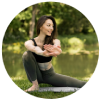During 200 hour yoga teacher training in Rishikesh at Omkar Aham Yoga Mandiram, our yoga teacher will teach you various asanas by combining the beautiful asanas of Hatha and Ashtanga Yoga. In this 200 hour YTT course, you will also learn the techniques to practice these asanas more effectively and smoothly. In addition, our yoga teachers will also teach you the benefits of each asana.
Yoga Asanas
Theoretical Practicum of Yoga Asanas Teaching
- Introduction to Yogasana
- Animal postures
- Yogasanas and Prana
- Yogasanas and kundalini
- Yogasanas and the body-mind connection
- Yogasana and exercise
- Dynamic and static yogasanas
Teaching Mythology Practicum of Yoga Asanas
- Breathing techniques during asanas
- Awareness in yoga Asanas
- Sequencing of yoga postures
- Counter pose
- Contra-indications
- Physical Benefits
- Spiritual Benefits
- Therapeutic Benefits
- Modifications and Variations
Practical Module Yoga Asanas
Multi Style Yoga Styles – Yoga asana Teaching styles:
- Hatha Yoga
- Yin Yoga
- Restorative Yoga
- Iyengar Yoga
- Vinyasa Flow
- Ashtanga Vinyasa Yoga
Category of Yoga asanas ( Yoga Postures )
- Relaxation Yoga Asanas
- Meditation Yoga Asanas
- Cultural Yoga Asanas
- Transidtion Yoga Asanas
Classical Hatha Yoga Yoga Asanas
Netra Yoga - Yoga for the Eyes
Pawanmuktasana Series
Part 1 : Anti-rheumatic Group
Part 2: Digestive/Abdominal Group
Part 3: Shakti Bandha Asanas
Cultural Yoga Asanas
- Vajrasana Group of Asanas
- Standing Asanas
- Surya Namaskara: Sun Salutations
- Chandra Namaskara: Moon Salutations
- Core Strengthening Yoga Asanas
- Padmasana Group of Asanas
- Hip Opening Asanas
- Kneeling Asanas
- Backward Bending Asanas
- Forward Bending Asanas
- Spinal Twisting Asanas
- Lateral Bending Asanas
- Inverted Asanas
- Balancing Asanas
Astanga Vinyasa Curriculum
Theoretical Practicum of Astanga Vinyasa Yoga
- History of Astanga Vinyasa Yoga
- Benefits and Limitations of Astanga Vinyasa Yoga
- Astanga Vinyasa Mantras ( Opening and Closing Prayers )
- Nava drishtis - The nine traditional gazing places
- Bandhas : Yogic Locks
- Awakening The Fire Within : Vinyasa - Movement Breathing System
- The Victorious Breath • Ujjayi Breathing
Practical Practicum of Astanga Vinyasa Yoga
Nava drishti - The nine traditional gazing places
Nasagra Drishti - the space just beyond the tip of the nose
Bhrumadhya Drishti - the space between the eyebrows
Nabhi chakra drishti - to the navel center
Hastagram Drishti - the hands or tips of the fingers
Padayoragram Drishti - feet or the tips of toes
Parsva Drishti - Left Side
Parsva Drishti - Right Side
Angusthamadhyam Drishti - the middle of the thumb
Urdhva Drishti - upward or outward
Samasthiti
Standing Balance Posture
Surya Namaskara A – 9 Vinyasa
Surya Namaskara B – 17 Vinyasa
Ashtanga Yoga Fundamental Asana
- Padangushtasana
Thumb to foot pose
- Pada hastasana
Hand to foot pose
- Utthita Trikonasana
Extended triangle pose
- Parivritta Trikonasana
Revolved extended triangle pose
- Utthita Parshvakonasana
Extended sideway angle pose
- Parivritta Parshvakonasana
Revolved extended sideway angle pose
- Prasarita Padottanasana (A, B, C & D)
Spread feet stretching pose
- Parshvottanasana
Sideways stretching pose
- Utthita Hasta Padangushtasana
Extended triangle pose
- Ardha Baddha Padmottanasana
Half bound lotus stretching pose
- Utkatanasana
Uneven pose
- Virabhadrasana (A & B)
Warrior pose
Yoga Chikitsa (Primary Series / 1st Series)
- Dandasana (Chaturanga Dandasana)
Four-Limbed Staff Pose (staff means spine, body support)
- Paschimattanasana ( 3 types A, B, C & D )
West-Back (extended-intense) stretching pose
- Purvatanasana
East-Front (extended-intense) stretching pose
- Ardha Baddha Padma Paschimattanasana
Half bound lotus forward pose
- Trianga Mukhaekapada Paschima
One foot transversely facing back forward stretch
- Janu Shirshasana (A, B & C)
Head to knee pose
- Marichyasana (A, B, C & D)
Marichya (Ray of light (of sun or moon)) pose
- Navasana
Boat pose
- Bhujapidasana
Arm pressure pose
- Kurmasana
Tortoise pose
- Supta Kurmasana
Sleeping tortoise pose
- Garbha Pindasana
Embryo in the womb pose
- Kukkutasana
Roster pose
- Baddha Konasana
Bound angle pose
- Upavishta Konasana
Seated angle pose
- Supta Konasana
Sleeping angle pose
- Supta Padangushtasana
Lateral sleeping thumb to foot pose
- Ubhaya Padangushtasana
Both thumbs to feet pose
- Urdhva Mukha Paschimattanasana
Upward facing forward stretch pose
- Setu Bandhasana
Bridge configuration (construction) pose
- Urdhva Dhanurasana
Elevated bow pose
- Paschimattanasana
West-Back (extended-intense) stretching pose
Ashtanga Yoga Finishing Positions
- Salamba Sarvangasana
All limbs pose
- Halasana
Plow pose
- Karnapidasana
Ear pressure pose
- Urdhva Padmasana
Elevated lotus pose
- Pindasana
Embryo pose
- Matsyasana
Fish pose
- Uttana Padasana
Extended foot pose
- Shirshasana
Head standing pose
- Baddha Padmasana
Bound lotus pose
- Yoga Mudra
Yoga gesture
- Padmasana
Lotus pose
- Uth Pluthi (Tolasana)
Sprung up
- Shavasana
Corpse pose




